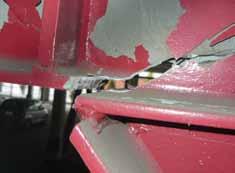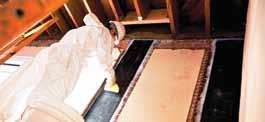
5 minute read
InSights
new trends, new techniques and current industry issues
Figure 1: Fractured EBF in Pacific Tower. Courtesy of Sean Gardiner, CPG New Zealand Ltd.
With a few notable exceptions, steel structures performed well during the Christchurch series of earthquakes in 2010 to 2011, even when subjected to ground accelerations that exceeded their design basis by a factor of more than Link Fractures in Eccentrically 1.5 in the most intense earthquake. Detailed Braced Steel Frames descriptions of this performance can be found in Clifton et al. (2011). It should be noted that By Michel Bruneau, Ph.D., P. Eng., Charles Clifton, Ph.D., FIPENZ, FNZSEE, Gregory MacRae, Ph.D., P.E., Roberto Leon, P.E., Ph.D. and Alistair Fussell, B.E.(Hons), ME, MIPENZ, CP Eng. most of the steel structures in Christchurch were of recent vintage and thus their performance is a good test of current seismic design provisions. The notable exceptions are fractures discovered in the links of two eccentrically braced frames (EBF), and these failures deserve further discussion. The first of these link fractures was discovered in the 22-storey Pacific Residential Tower (the tallest building in Christchurch, completed in 2010). The building consists of perimeter EBFs up to the sixth floor on the western side and up to the eleventh floor on the north side of the building, shifting to join the other EBFs around the elevator core above that level, with transfer slabs designed to horizontally distribute the seismic loads at those transition points. Several sections of the EBFs at levels below the level 6 transfer slab were visible, as these levels housed a mechanical multilevel parking elevator system. Paint flaking and residual link shear deformations were observed in the EBF links at those levels. Design of the EBFs in that building was governed by the need to limit drift, with a corresponding resulting design ductility factor (µ) of 1.5 (even though up to 4.0 is permitted for EBF systems in New Zealand). This is typical of EBFs in tall buildings in that country’s moderate seismic zones (like Christchurch), and a more typical design ductility factor range for such buildings is 2 to 3. When the initial internal The online version of this article inspections were undertaken, there was an absence contains references. Please visit of significant damage to architectural and other www.STRUCTUREmag.org. non-structural finishings, except at level 6 where a few of the hotel room doors along the corridor could not be closed, suggesting greater residual deformations at that level. This level was the first in which a detailed evaluation was undertaken. One fractured EBF active link was discovered (Figure 1) at that level. The fracture propagated from one top corner across the active link region and resulted in significant residual deformation. Temporary strap cross-bracing was welded to the active link frame to provide lateral load resistance while a repair strategy was developed. The active links in the top 4 stories of this frame were subjected to higher inelastic demand than any other frame. These 4 links had a link length of only 400mm, half the link length of the other links in the bulding, accounting for the greater magnitude of inelastic demand. The 4 links are being replaced. This replacement will comprise cutting out the active link and a proportion of the collector beam and brace, and site welding new components back in. This method has been used successfully in the second building with fractured links (Figure 2), which is now repaired and back in service. The welding sequence was developed to minimize locked-in residual stresses. The replacement of this fractured link and the three links below are being undertaken in March 2012, and are the only repairs required to the structural system. This type of failure has not been reported in either EBFs tested in the laboratory or from damage reports from other earthquakes; the reasons for this link fracture are not currently clear and all 4 links will be the subject of detailed metallurgical and structural evaluations once they are removed. Fractures were also found in two bays of a low-rise parking garage having eccentrically braced frames (Figure 2). For a number of reasons explained elsewhere (Clifton at al.), this parking garage was not subjected to ground motions as severe as those felt elsewhere in Christchurch. However, because these EBFs were not drift dominated, they were designed for the maximum µ = 4 ductility demand. The cause of failure has been speculated to be due to an unintended offset observed between the brace flange and the link stiffener. As a consequence of this offset, the axial tension force in the brace fed into the active link/collector beam panel zone through a
flexible beam flange rather than directly into the stiffener, severely overloading this junction area, possibly leading to a fracture that spread across the beam flange and through the web. This suggest that load path through the as-constructed detail is particularly important when inelastic demand is required from the system. Note that at least six EBF frames were used at each level in each of the buildings’ principal directions, and that this significant redundancy contributed to maintaining satisfactory seismic performance of the building in spite of those significant failures. Also, residual drifts of the parking structure or damage to the gravity load carrying system were not visually noticeable, which suggests that these fractures would have not have been discovered if hidden by non-structural finishes. As noted above, the fractured active links have been cut out and replaced to bring the building back into service.

Figure 2: Parking garage with fractured link at lower level EBF. Courtesy of Greg MacRae.
Conclusions
Although steel structures performed well in the February 22, 2011 Christchurch earthquake and in the numerous other similar events that hit the city between September 2010 and June 2011 as noted by Clifton et al., it is instructive to note that even robust systems such as EBFs can be susceptible to failure when the forces are large. It is expected that the ongoing investigations into detailing practices and material properties will shed light on these two unusual, localized failures.▪

Michel Bruneau, Ph.D., P. Eng., Professor, Dept. of Civil, Structural, and Environmental Engineering, University at Buffalo, Buffalo, NY, USA. Charles Clifton, Ph.D., FIPENZ, FNZSEE, Associate Professor in Structural Engineering, Dept. of Civil Engineering, University of Auckland, Auckland, New Zealand. Gregory MacRae, Ph.D., P.E., Associate Professor in Structural Engineering, Dept. of Civil and Natural Resources Engineering, University of Canterbury, Christchurch, New Zealand. Roberto Leon, P.E., Ph.D., Professor, Via Department of Civil and Environmental Engineering, Virginia Tech, Blacksburg, VA, USA. Alistair Fussell, B.E.(Hons), ME, MIPENZ, CP Eng., Senior Structural Engineer, Steel Construction New Zealand, Manukau City, New Zealand.

Acknowledgments
This work was funded in part by the Foundation for Research in Science and Technology of New Zealand, the Universities of Auckland and Canterbury, and MCEER (University at Buffalo). However, opinions presented here are solely those of the authors.










